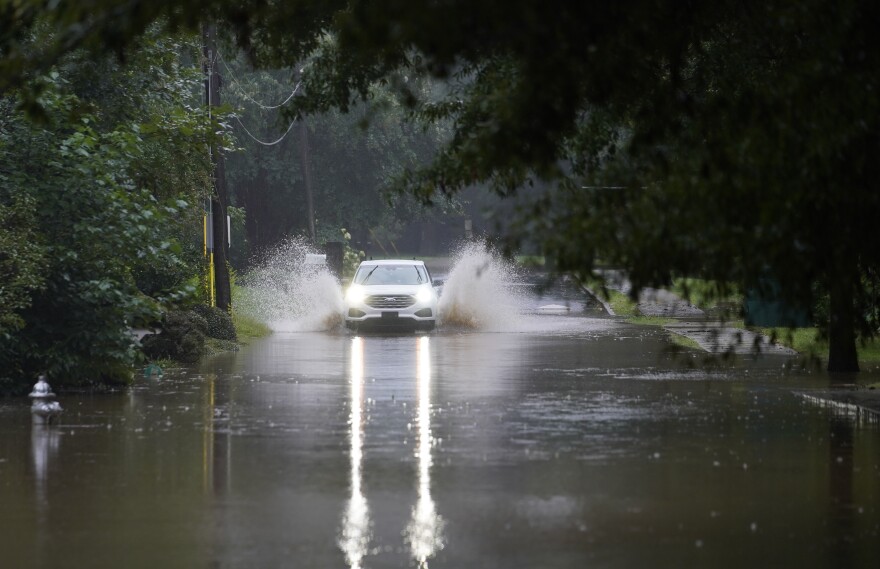Tropical Storm Fred weakened to a depression and spawned several apparent tornadoes in Georgia and North Carolina on Tuesday as it dumped heavy rains into the Appalachian mountains along a path that could cause flash floods as far north as upstate New York.
One death was reported — a Las Vegas man whose car hydroplaned near Panama City, Florida, Monday night and overturned into a water-filled ditch, the Florida Highway Patrol said.
Fewer than 30,000 customers were without power in Florida and Georgia after the storm crashed ashore late Monday afternoon near Cape San Blas in the Florida Panhandle. Emergency crews were repairing downed power lines and clearing toppled trees in Fred's aftermath. Some schools and colleges in Florida, Alabama and Georgia cancelled Tuesday's in-person classes due to the storm.
The National Hurricane Center said Fred had top sustained winds of 35 mph (56 kph) as it crossed southeast Alabama into western and north Georgia. Senior hurricane specialist Stacy Stewart said Tuesday that it could dump 5 to 7 inches (13-18 centimeters) of rain into parts of Alabama, Georgia and the Carolinas — and possibly up to 10 inches (25 centimeters) of rain in isolated spots, causing flash flooding in mountainous areas.
Clay Chaney, a meteorologist with National Weather Service, said a local fire chief in North Carolina told the agency a tornado was on the ground in northern Iredell County around 12:47 p.m. The weather service was also looking into reports of a tornado hitting Alexander County.
Parts of western North Carolina, already soaked by rain not directly associated with Fred, braced for more rainfall through early Wednesday. Transylvania County, south of Asheville, declared a state of emergency after 10 inches (25 centimeters) fell Monday, causing landslides, flooding roads and destroying at least one home.
Transylvania County Chairman Jason Chappell, a lifelong resident, said it was the most intense flooding he’s seen in at least 20 years, and that he fears more damage to come. Floodwaters swamped a local factory Monday with several inches of water and damaged its parking lot.
“It really caught everyone off guard,” Chappell said. “No one was forecasting that amount of rain.”
The North Carolina Department of Transportation said two of three westbound lanes of Interstate 40 in Haywood County, west of Asheville, were closed Tuesday afternoon due to a rockslide triggered as the rain blew through.
With Fred blowing in Tuesday, National Weather Service meteorologist Ashley Pratt said Haywood, Transylvania and Jackson counties are likely to get the most rain, including another 6 to 8 inches (15 to 20 centimeters) in Transylvania.
One of the region’s major attractions, Grandfather Mountain State Park, closed on Monday. The North Carolina state park’s website said “trails are flooded and the water at stream crossings (is) dangerously high.”
At least three apparent tornadoes touched down in Georgia: One hit Americus, in the southwestern part of the state, one hit a rural area of Meriwether County, between Atlanta and Columbus, and one hit Jeffersonville, near Macon, according to the National Weather Service.
The storm hit Americus around 1:30 a.m., knocking over trees, with some falling on houses, and downing power lines, WRBL-TV reported.
An Academy Sports warehouse near Jeffersonville was hit by another likely tornado before 6 a.m., with metal siding torn off the building, a semi truck trailer tipped over and Twiggs County Sheriff Darren Mitchum telling WMAZ-TV that eight boats were scattered around by the storm. Weather officials warned of a tornado in the Jeffersonville area as well.
Heavy rains drenched parts of metro Atlanta just before dawn Tuesday, snarling commutes.
Meanwhile, reconnaissance aircraft found Grace regained tropical cyclone strength early Tuesday. Grace lashed earthquake-damaged Haiti as a tropical depression on Monday, dumping up to 10 inches (25 centimeters) of rain that pelted people huddling under improvised shelters in the aftermath of Saturday's 7.2 magnitude earthquake, now blamed for more than 1,400 deaths.
Grace's sustained winds grew to 45 mph (75 kph) as it left Haiti on a westward path between southeastern Cuba and Jamaica. Forecasters said it could be near hurricane strength as it approaches Mexico’s Yucatan peninsula late Wednesday or early Thursday.
Tropical Storm Henri, meanwhile, was about 135 miles (215 kilometers) south-southeast of Bermuda. The small tropical cyclone had 50 mph (80 kph) winds and was expected to circle widely around the island, the hurricane center said.






